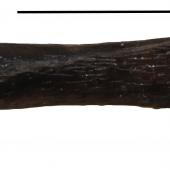New Zealand lake-wanderer
Hakawai melvillei De Pietri, Scofield, Tennyson, Hand, Worthy, 2016
Order: Charadriiformes
Family: Incertae sedis
The New Zealand lake-wanderer was described from 52 bones recovered from 19-16 million-year-old (Early Miocene) lake-bed deposits along the Manuherikia River and nearby Mata Creek, St Bathans, central Otago.
The holotype (NMNZ S.50806, a right tarsometatarsus) is held at Museum of New Zealand Te Papa Tongarewa (Te Papa). The eight paratype skeletal elements are held at Te Papa (6) and Canterbury Museum (2), along with 43 other skeletal elements.
The New Zealand lake-wanderer was a small, long-legged wader similar in size to a male (Australian) plains-wanderer Pedionomus torquatus (i.e. about 54 g). Based on limb-bone proportions, it was probably a competent flier that fed in shallow water. Some elements found were not skeletally mature, indicating that the birds bred locally, rather than being migrants from elsewhere. The discovery of bones of both adults and juveniles in sediments deposited in shallow lake margins suggests that this is where it preferred to live.
Skeletal features place the New Zealand lake-wanderer in a clade that includes both the plains-wanderer (Pedionomidae) and the South American seedsnipes (Thinocoridae), with the plains-wanderer as its closest relative. However, it was sufficiently distinct that it may deserve placement in its own family, as recognised in the common name proposed here.
The genus name is based on the mythical Hakawai bird of Māori legend, now recognised as being a nocturnal aerial display by Coenocorypha snipe. The species name honours New Zealand-based ornithologist David Melville for his efforts to advance shorebird conservation locally and globally.
Weblink
References
De Pietri, V.L.; Scofield, R.P.; Tennyson, A.J.D.; Hand, S.J.; Worthy, T.H. 2016. Wading a lost southern connection: Miocene fossils from New Zealand reveal a new lineage of shorebirds (Charadriiformes) linking Gondwanan avifaunas. Journal of Systematic Palaeontology 14: 603-616.
Miskelly, C.M. 1987. The identity of the hakawai. Notornis 34: 95-116.
Recommended citation
Miskelly, C.M. 2015 [updated 2016]. New Zealand lake-wanderer. In Miskelly, C.M. (ed.) New Zealand Birds Online. www.nzbirdsonline.org.nz
New Zealand lake-wanderer
- Breeding season
-
- Jul
- Aug
- Sep
- Oct
- Nov
- Dec
- Jan
- Feb
- Mar
- Apr
- May
- Jun
- Egg laying dates
-
- Jul
- Aug
- Sep
- Oct
- Nov
- Dec
- Jan
- Feb
- Mar
- Apr
- May
- Jun









